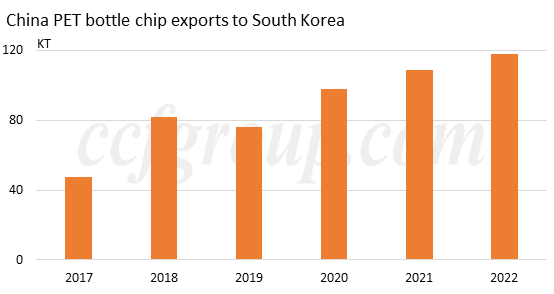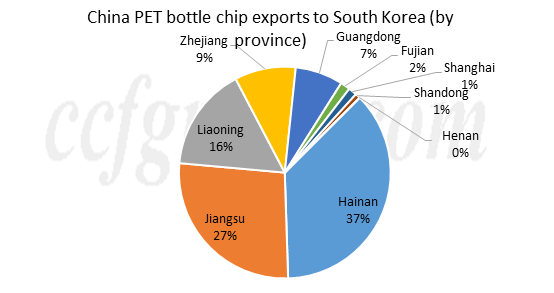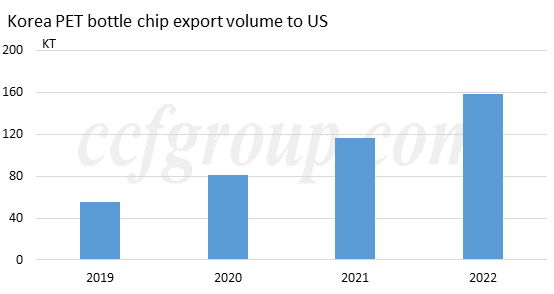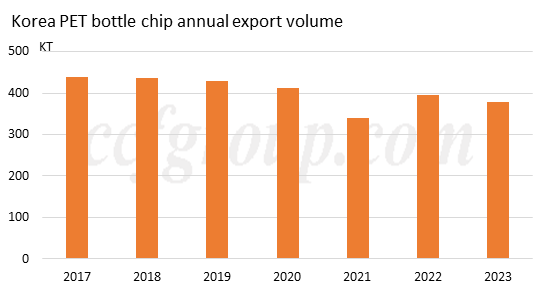Impact of South Korea anti-dumping investigation on Chinese PET resin
Recently, the Korea Trade Commission announced on January 12th that it has initiated an anti-dumping investigation on PET resin originating from China. The Korean tariff code for the implicated products is 3907.61.0000. The Chinese companies involved include Hainan Yisheng Petrochemical Co., Ltd., China Resources Chemical Materials Technology Co., Ltd., Yisheng Dahua Petrochemical Co., Ltd., and Zhuhai China Resources Chemical Materials Technology Co., Ltd. The preliminary ruling in this case will be made within three months. Previously, it was reported that Korean companies proposing the imposition of an 18.6% anti-dumping duty on PET imports from China.
So, how will this anti-dumping investigation launched by Korea impact the export of PET resin from China?
In fact, before the United States, Japan, and Europe set trade barriers against Chinese PET resin enterprises, the quantity of PET resin exported from China to Korea was not significant. Prior to 2015, the export volume of Chinese PET resin to South Korea was only around 10,000 tons (e.g., 12,000 tons in 2013), accounting for less than 0.7% of the total. However, starting from 2016, the import of PET resin from China to Korea has grown rapidly. This is primarily because after the United States and Japan initiated anti-dumping investigations against Chinese PET resin from 2015 to 2017, Chinese PET resin enterprises started using the Korean market as a transshipment point. At the same time, the tariff imposed by US on imports from Korea has gradually decreased to zero, creating a market void. By the end of 2022, Chinese exports of PET resin to Korea had reached 118,000 tons, nearly nine times the cumulative growth in the past decade. In 2018, China's exports exceeded 80,000 tons for the first time, accounting for around 3% of China's total exports of PET bottle chip.

Based on China's customs data for 2023, PET resin export volume to Korea is still substantial. The export volume of PET resin from China to Korea in the first 11 months of the year has reached around 137,000 tons, and it is expected to increase to around 150,000 tons for the whole year, reaching a historical high. However, with Korea officially launching an anti-dumping investigation on Chinese PET resin, the export order of Chinese PET bottle chip to Korea is expected to decrease rapidly in response to the potential imposition of anti-dumping tariffs. Of course, due to existing contracts, a small amount of shipments may still be reflected in customs data in the short term. Looking at the provincial data for China's exports to Korea in 2022, Hainan, Jiangsu, Liaoning, Zhejiang and Guangdong accounted for a total of 114,000 tons, or 96.6% of the total. The implicated Yisheng and China Resources factories are mainly located in Hainan, Liaoning, Guangdong and Jiangsu regions. If we exclude the quantity from Zhejiang, the total still reaches around 103,000 tons. Therefore, other PET bottle chip producers are unlikely to be significantly affected by this Korean anti-dumping investigation.

Now, let's take a look at the supply and demand situation in Korea itself. There are two major PET resin manufacturers in Korea: TK Chemical and Lotte, with production capacities of 300,000 tons and 500,000 tons, respectively. Lotte's main market is the European Union, while TK Chemical supplies both domestic and export markets, including the United States and the European Union. According to CCFGroup statistics, the domestic apparent consumption in Korea is around 400,000 tons, with annual exports around 395,000 tons in 2022 and imports around 120,000 tons. Assuming full capacity utilization of 800,000 tons per year without competition from external players, theoretically, they still need to export around 400,000 tons to maintain supply-demand balance. However, if the domestic market share is occupied by foreign competitors and the export market performs poorly, the situation for Korean PET bottle chip manufacturers may not be favorable, especially against the backdrop of declining demand from Europe and the United States in 2023. According to customs data, from 2019 to 2022, Korea's exports of PET resin to the United States increased from around 55,000 tons to nearly 160,000 tons, almost doubling and accounting for nearly half of the total exports.

Between 2017 and 2023, Korea's exports of PET resin gradually declined from nearly 440,000 tons to less than 380,000 tons, a decrease of over 13%. The failure in the export market forced Korean companies to increase their domestic market share. During this period, Chinese PET bottle chip enterprises have increased their market share in South Korea to more than 20%. On the one hand, this is because Korean PET bottle chip enterprises have not invested in new capacity for many years, and there is still a supply gap in the domestic market in years with outstanding export performance, and local prices are relatively high. On the other hand, in the past few years, Korean PET bottle chip enterprises have relied too much on the export market and to a certain extent ignored their domestic market. Additionally, the increased upstream raw material capacity in China in recent years has also added more cost advantages to PET bottle chip exports.

Overall, because the proportion of PET bottle chip exported to South Korea is not large, and it mainly affects Yisheng and China Resources, we believe that the impact on the overall export situation of Chinese PET bottle chip enterprises will be limited in the future. However, the two companies involved in the case may need to actively defend themselves in order to achieve a better result. The initiation of this anti-dumping investigation may be the last straw for Korean bottle chip enterprises to save themselves, waiting for the market to test it.
- Top keywords
- Cotton Price
- Cotton Futures Price
- Cotton Futures
- CZCE
- PTA Futures Price
- Chemical Fiber
- Polyester Prices
- Wool price
- PTA Futures
- Shengze Silk
- China
- Yarn Price
- price
- China Textile City
- Fibre Price
- Benzene Price
- Cotton
- Index
- Cotton Index
- PTA
- fabric price
- NYMEX
- Top 10
- textile industry
- Spot Cotton
- Cotton Yarn
- Polyester Price
- Futures
- PTA Price
- cotton yarn price

